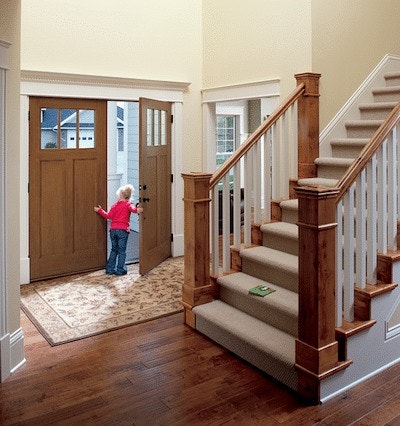Showcase Your Home's Craftsmanship
Posted
on November 21, 2017

Craftsman is an American homegrown architectural style. As with all things American, craftsman is a fusion of many influences including Asian architectural details, English Arts and Crafts movement and the always-fresh southern California spirit.
American craftsman homes started popping up in the very early 1900s in California and became extremely popular from 1900 to 1930. As the 20th century progressed, other home designs supplanted the craftsman. Since the 1990s, craftsman-influenced design has been making a comeback.
What is a Craftsman Style house?
The name craftsman comes from the Arts and Crafts movement, which started in England in the mid-1800s and quickly spread. The heart of the movement was an emphasis on artisanship that resulted in products that were well designed, carefully produced, and often skillfully decorated. The trend toward seeking beautiful products of excellent craftsmanship was a reaction to the poorly designed, shoddy mass-production products of the day.
In general, the distinct elements of a craftsman house testify to the craftsmanship of the builder.
Craftsman Style House Characteristics
Outside
- Low pitched roof lines, gabled or hipped roofs and deeply overhanging eaves with exposed rafters.
- Tapered, square columns supporting the roof. These columns are typically short and rest on massive stone or brick piers that extend to ground level.
- Double-hung windows, often with a four-over-one or six-over-one grille configuration.
- Partially paned doors. Nearly all original craftsman homes have thick glass panes in the upper third part of the front door.
- Large covered front porches or similarly impressive outdoor entryway.
- Outdoor architectural detail.
- Thick exterior trim around windows and along eaves.
- Combinations of board-and-batten and shake siding or horizontal lap siding and shake siding.
- Earthy neutral paint colors.
Inside
- Built-in cabinetry and large fireplaces often with built-ins on either side.
- Exposed wood beams, wooden window frames, and thick baseboards/crown molding.
- Extensive use of stained wood, rather than painted wood.
Contemporary Craftsman
Since most original craftsman style homes are nearly eighty years old now, for better or worse they symbolize a by-gone era in America. Just as modern car designers will never exactly copy something from 1956, neither will today’s residential architects bring back the original craftsman. Plus, many of today's homeowners have shifted to favor open-concept floorplans over the craftsman home's rectangular-based, multi-room floorplan.
Many homeowners today are drawn to contemporary craftsman style, which embraces the motivation for the original (to showcase builders’ craftmanship), just expresses it in a modern way. The result is a modern design that incorporates some of the classic craftsman elements above but with modern materials and contemporary floor plans.
Adding Some Craftsmanship to Any Home
A few ways to embrace the spirit of American craftsman in whatever kind of house you live in include:
Replace your Front Door — The hallmark of craftsman-style front doors is glass in the upper third with a thick or ornate piece of trim immediately below. The glass panes are usually rectangular, but the number of panes varies widely. The door frame sometimes also has rectangular glass panes above (transom) and beside (sidelights) the door.
Check out this recent project where homeowners updated their home's entry with a craftsman style entry door.
Add Some Nature — Craftsman homes are heavy on exposed wood and stone, and feature natural tones like browns and greens. To get the look, add exposed beams and stained woodwork inside. Built-in cabinets with glass-paned doors and bookshelves with wood trim and simple horizontal and vertical geometries are classic craftsman. You can also have interior elements that mimic exterior elements, such as the quintessential craftsman tapered columns.Stained Glass — In original craftsman homes, stained glass was the real deal. Today’s technology makes it easy — and much more affordable — to add lighting fixtures that mimic stained glass inserts such as pendant lights, or even stained glass in the front door.
While the early 1900s execution of craftsman style is probably gone for good, the spirit behind that expression is alive and well.
Schedule a free consultation to find windows and doors for your home.
